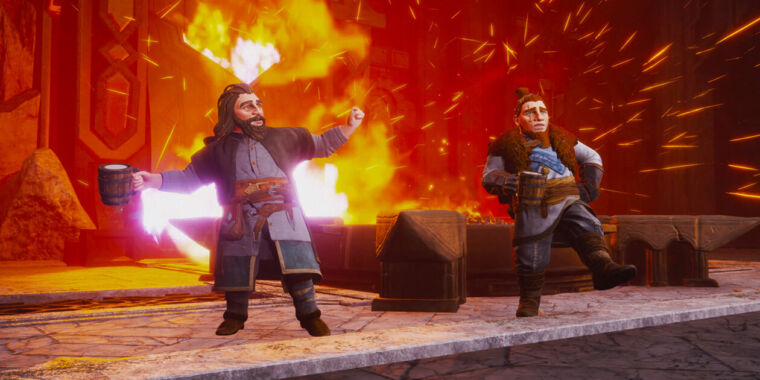North Beach Games
The dwarves of J.R.R. Tolkien’s writing are, according to the author himself, “a tough, thrawn race for the most part, secretive, retentive of the memory of injuries (and of benefits),” and “lovers… of things that take shape under the hands of the craftsmen rather than things that live by their own life.”
Is it secrecy and avarice that explains why The Lord of the Rings: Return to Moria spent its first year of existence as an exclusive to the Epic Games Store? None can say for certain. But the survival crafting game has today arrived on Steam and Xbox, adding to its PlayStation and EGS platforms and bringing a 1.3 “Golden Update” to them all. Steam Deck compatibility is on its way to Verified, with a bunch of handheld niceties already in place.
The Golden Update grants new and existing players a procedurally generated sandbox mode to complement the game’s (also generated) campaign, new weapons and armor, crossplay between all platforms with up to eight players, specific sliders for difficulty settings, and… a pause function in offline single-player, which seemingly was not there before.
Launch trailer for Return to Moria on Steam and consoles (and its Golden Update).
What are you actually doing in Return to Moria? You, a dwarf in the Fourth Age of Middle-Earth, are tasked by Gimli Lockbearer with heading into Moria (i.e. Khazad-dûm) to recover its treasures. Except every Moria is different, generated from random generation seeds. You mine for materials, use materials to make gear and goods, set up base camps with stations and fixtures, and, of course, fight the things you awaken in the depths.
-
The campaign is procedurally generated, but it tells a narrative with a beginning, middle, and end. And runes—lots of runes.
North Beach Games -
Dwarves? Underground? Making stuff? Yes, of course.
North Beach Games -
There will be goblins.
North Beach Games
Not only does a release on new cross-compatible platforms give you a chance to check out a potentially overlooked gem, but this is also version 1.3 of the game. Reviews of the game at release in October 2023 were closely aligned around one point: it needed more time to cook.
PC Gamer found the game authentic to Tolkien’s lore, intriguing in its depictions of underground spaces, and alternately goofy and harrowing in building and fighting. But bugs, stuttering, clipping errors, and disbelief-shattering oddities brought the experience down a good deal. Polygon was more critical of the game’s tile-based layouts and laborious backtracking. “A few patches could see this become a survival game that can hold its own against the more popular entries in the genre,” wrote Ford James.
In a “Quality of Life Showcase,” Game Director Jon-Paul Dumont details how the game has advanced over the past 10 months. The map is color-coded and easier to read, the ambient music and transitions are improved, combat improvements make it feel better and more grounded (another point of review contention), and player gripes about inventory management, cooking, building, and crafting have been tackled.
I haven’t played enough of the game to render any kind of verdict on it, but I’m always eager to see the work of a team actively fixing after launch—digging in, if you will.










